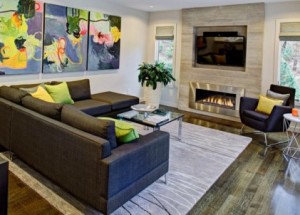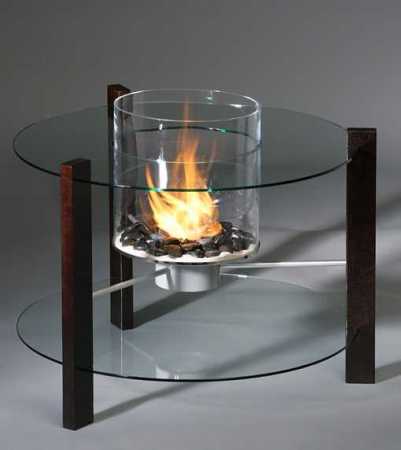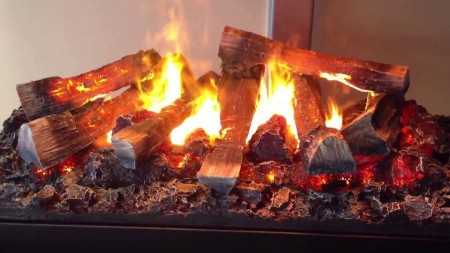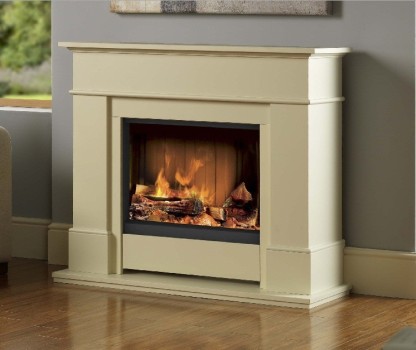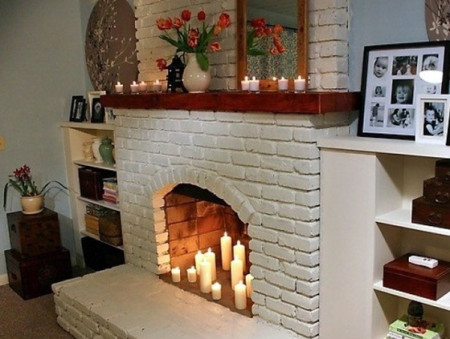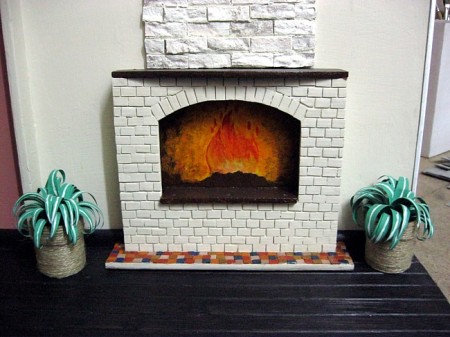Fireplaces working on firewood are endowed with some peculiarities, they could catch on mostly in suburban private estates. First of all, the peculiarities concern the fuel used in fireplaces of this kind. Its use in apartment conditions is unrealistic, since there is a risk of fire and no fire safety service will give permission for installation.
In addition, to store the wood itself will need a decent size of the area. In their own house, things are different: the fireplace on the wood will create a cozy and unique home atmosphere, if desired, can be used as a primary or additional source of heat, it can become a place for cooking.
Content
Fireplace Options
For the construction of fireplaces and their decoration are used a variety of materials, we will consider the most popular among them.
modern fireplace made of bricks, working on wood
The fireplace looks like a stove, which has a directly located chimney and an open firebox. The usual material for its construction is brick. The best option is to use in the construction of chamotte or red kiln brick, which is characterized by its fireproof properties and can withstand sufficiently high temperatures.
If a combination of iron and brick is projected, then do not forget about the fragility of metal when operating under extreme conditions. It should also be noted that the construction of fireplaces does not use silicate brick, it is not a fire-resistant material and will decompose very quickly when temperature drops.
Both the chimney and the furnace are the main components of the design of any type of fireplaces. The furnace is designed to contain combustion products in it, that is, in our case, logs and coal, with the help of which ignition occurs. This process is aimed at ensuring the functioning of the device for heating in general.
A chimney is a pipe that is located vertically, along which the output of combustion products comes out and traction is carried out.
In addition to the required fragments, in the fireplace there can be the following optional components:
- chamber for collecting smoke (located directly above the furnace and responsible for the supply of gases into the pipe);
- portal (decorative fragment located in front of the fireplace, which can have a different shape as close as possible to the interior);
- a grate made of cast iron, on which the firewood is laid;
- a smoke tooth (located on the back of the fireplace wall, prevents smoke and outside cold air from entering the house).
cast-iron fireplaces and their features
To date, fireplaces for your own home can be made not only from brick or stone, but also from metal such as cast iron. The design of such a fireplace has some differences from fireplaces made of other materials.
A furnace for a cast iron fireplace is made only in production. And in addition to the furnace and chimney, a fireplace made of cast iron has:
- portal - made of refractory materials, for example, such as brick, marble, metal;
- doors - are made mainly of refractory glass, whose properties prevent the soot from settling on them and soot.
Also worth noting is the special plus of the cast-iron fireplace: its efficiency is much higher than that of its brethren and reaches almost 80%. One fireplace of this kind will be enough to heat a house with a small quadrature.
Due to this property of cast iron, as resistance to changes in the temperature regime, the structure from it does not lend itself to deformation from the high temperature.
In shops specializing in the sale of fireplaces you can choose a product for every taste and financial possibilities.
Fireplace cast iron constructions are of three types:
- open,
- half-open,
- closed.
how to choose a place for a fireplace
The main feature of closed fireplaces is their chimney and furnace built into the internal or external wall.
In size they are very compact and can be located in small rooms. Arrangement of a fireplace of this kind, should be thought out even while drawing up a project of building a house. This is due to the fact that to mount the fireplace design, walls with a certain thickness are needed. Such installation will affect the strength of the wall. This fact is important and must be taken into account in the project without fail.
The design of a semi-open fireplace is usually located in close proximity to the wall or in the corner between the walls.
The efficiency is significantly less than that of a closed type, but the design features allow the heat to be distributed to a large quadrature.
The location of the fireplace in the corner is the competent use of free space, as well as additional heating of nearby rooms and other rooms.
Open fireplaces do not share borders with walls in the room.
All sides of his furnace are open. Can be made of either stone or brick, and metal. Its installation is carried out on supports or suspended in the center of the room.
If desired, you can make a little effort to create a fireplace in a certain design and make it the main, and even the heating, piece of design. Specialists advise an open fireplace to be installed only in rooms with an impressive area.
In addition to its originality, it also has its significant shortcomings. First, a high percentage of fire situations. Secondly, in cases of its suspension to the ceiling, special attention should be paid to the fastening system (its weight is not small) to avoid accidents. Thirdly, it can only be placed in a room with a sufficiently high ceiling. Fourth, the efficiency of this species is the lowest among all the options described above.
decorative fireplace - original interior decoration
When the apartment has absolutely no conditions for installing a real fireplace or even an electric installation, you can still enjoy the open fire.
To do this, you will need to purchase, or make your own, a bio fireplace, or eco-fireplace. This is quite a modern product of design refinements and technological innovations. Obtaining open fire in an environmentally friendly device does not lead to the emission of soot or smoke, the formation of ash.
Also, no installation of any chimney will be required, because ethanol or denatured alcohol is used as fuel for bio-fireplace.
Biofireplaces are mobile devices, they can be transported at will, the fire is real, and their operation does not create any difficulties. For the production of bio-fireplaces, sufficiently attractive materials are used, which allows them to be positioned as an element of the decor of the room.
electric fire-place
Of course, burning natural logs exude a special aroma, special warmth and energy, but if it is not possible to equip a real fireplace in a certain room, for example, in a high-rise apartment, you still have to turn to the installation of an electric fireplace. Even an electric copy of the home can transform the housing beyond recognition, fill it with comfort.
For skeptics, it should immediately be noted that the imitation of flame in modern electric fireplaces is of a high quality, the flame pattern is never repeated, the shades of its languages are rather natural, which is provided by rather complicated engineering calculations.
Install an electric fireplace with the effect of a living fire without fear, it is suitable for a normal city apartment and a country house. Its installation and operation does not create problems that usually arise with classic fireplaces.
The design of the electric fireplace may be different:
- It can be equipped with a portal, the decorative properties of which allow you to maximize its appearance to the form of a classic wood-burning fireplace, traditional marble, tiles, stucco can be used for decoration.
- Stand-alone, in appearance similar to the classic cast iron stoves.
- Cramp-like, also installed separately, in appearance they have a similarity with drovnitsami. For their manufacture use metal sheets and rods.
- Cabinet, suitable for installation in rooms of small dimensions, if desired, they can be built into pieces of furniture.
The design of all types of electric fireplaces with the effect of fire contains the same elements:
- decorative frame,
- the lattice, which simulates the grate bars,
- capacity, i. The furnace with the wood and coal placed inside the house,
- a device that simulates a flame.
This is how a "live fire" looks:
Fireplace in the interior of the house
A fireplace is one of the elements that can make a home really cozy. Install classical fireplaces usually in the living room, for smaller rooms it is more rational to use electric or eco-fire. If the construction of an operating fireplace - a problem that is too time-consuming, or unsolvable in terms of technical, resort to the construction of a false shield.
This is an exclusively decorative element that is used as a decoration of the room. Falshkony can be reliable, i.e. have the dimensions of this fireplace and a design that allows you to install in their furnace a bio- or electric fireplace.
A conditional fireplace should have protruding walls, allowing the placement of the same electrical or environmental analogues inside it. A symbolic fireplace can have any size and appearance, in principle it can be a drawing in the format 3 D, applied to the wall.
Choosing a fireplace finish, you should think about an option that would be combined with other pieces of furniture and decor, available in the room, both in style and color. Classic fireplaces perfectly discharged both in the classic interior, and in its modern styles.
Interesting ideas for creating falshkamins:
We make a fireplace with our own hands
Despite the fact that in specialized stores a wide selection of various fireplaces is provided, some owners prefer to make this fragment of the interior, independently. On the Internet, on sites specializing in this subject, you can find a lot of videos with detailed instructions and additional schemes for laying a stone. In general, they give a fairly clear idea of exactly how the work should take place.
One of the simplest versions of a fireplace masonry is brick. First of all, it is necessary to draw out drawings, which will depict different angles of the fireplace: in a section, from the side, from the top, straight. Well-designed and detailed drawings, prevent possible building errors and help to make the correct calculation of the required initial amount of building material.
foundation for the fireplace
The next crucial step is the calculation and erection of the foundation. The base of the fireplace must be strong and reliable. We must remember: the foundation for the walls and for the fireplace can not be the same, since the load on them will be different, and therefore, shrinkage, too.
Proceeding from this, between the fireplace foundation and any other, you need to leave a gap of 5 centimeters and fill it with sand. The width of the fireplace basement should be more than the fireplace table, about 5 centimeters. The depth of the base should be about half a meter. For the production of the foundation, the following materials can be used: crushed stone, gravel, brick, and for their bonding: a solution based on pure cement or with the addition of lime.
Details on the construction of the fireplace - on the video:
Brick masonry is made in accordance with the scheme-order.
chimney for a fireplace built with knowledge
The next steps are careful design and installation of the chimney. The installation process can be different, it all depends on the material selected. The best option is a brick. Its installation is based on the following processes: foundation production, ordering, solution dilution, swabbing, heading, smoke.
check the traction - how to determine the strength and direction without special expensive devices
The activity of burning wood in the fireplace and the cleanliness of the air in the room largely depend on the thrust, and special attention must be paid to checking it. This concept denotes the strength and direction of the main streams: air and smoke, it can be directed to both the chimney and the house. Changing the direction of the thrust or its weakening can occur both in the process of heating the fireplace, and with natural ventilation in the room: air currents always tend towards a lower resistance.
To learn how to determine the traction force and its direction visually, you can use the following useful tips from the masters:
- at excess draft the color of a flame aspires to white, from a chimney buzz is heard,
- at normal draft the flame is calm and has a pleasant golden color,
- with a weak draft, the flame acquires a red tinge with brown strips - due to the insufficient amount of oxygen for combustion,
- with the return draft all the smoke from the combustible firewood goes into the room.
Determine the presence of traction and the direction of air flow can be using a flame match or a cigarette lighter. Kindle the fireplace only if you make sure that the thrust is normal.
Those who have a long experience of using stoves on firewood or fireplaces adapt as a "measuring device" to use strips of light paper, or smoke from a lit cigarette.
Useful tips for those who are going to build a fireplace with their own hands
Before you begin the construction process, you need to determine the exact amount of materials that will be needed for the construction, decoration and design.
Experts argue that the most acceptable option for self-construction is a fireplace that is attached to the wall. Its construction can be organized in already lived-in premises and the erection will not violate the integrity of the walls or require additional changes in the layout of the building.
If there is no desire to bother with construction, then you can buy a ready-made fireplace from cast iron in a specialized store and install it.
Beginners in this type of construction, before starting work, should carefully study the thematic information, professional advice, photo-lessons. They will help to significantly reduce the time costs of construction, as well as help to build a safe, functional design for heating.
The advantages of wood-burning fireplaces
Types of stoves-fireplaces differ among themselves as follows: the material of which is made, the dimensions, purpose, shape, power.
These devices are given a kind of aesthetics, practicality, and their cost is much lower than the standard analogues. True, they also have one important drawback: their use can only be regarded as an additional source of heat. Unfortunately, they can not compete with boilers running on solid fuel or gas. It is also worth mentioning that kilns of this kind spend a lot of fuel, but despite this, their consumption is still less than that of furnaces operating on wood.
Even though furnaces of this kind can only be used as auxiliary structures, the owners will note their advantages and will be indispensable in cases of gas interruptions in the winter. At such times, the furnaces can protect the room from complete cooling, the heating system from freezing, and users from unnecessary financial costs and stressful situations.


